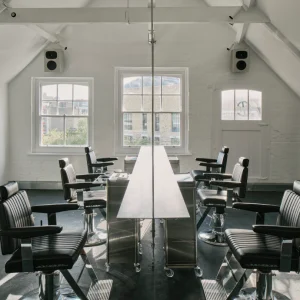An email entitled: ‘Manifesto for Design: Why the Global Design Forum missed the mark’ from Martyn Perks, one of the ‘Big Potatoes’ team working on their own Manifesto for Design, opens thus:
‘Dear Colleague,
Read why our very own Manifesto team member, Richard Eisermann, lays into the recent Global Design Forum, asking why it didn’t live up to its stated goal of being "one day to set the global agenda for design".
If you were there and felt the same, or are otherwise frustrated by the overwhelming lack of debate in design, then join us in leading a proper debate about the worth and value of design, with an international audience.
Pass this on, spread the word and get stuck in! The Manifesto team’
OK Martyn, so you guys are working on a manifesto for design. All good – or so it should be. Eisermann’s critique of the Global Design Forum – of which I was the programme co-ordinator, to declare my interest right up front – expresses impatience with the day’s proceedings, basically because there wasn’t enough time for debate. ‘The Global Design Forum,’ says he, ‘… was billed as "one day to set the global agenda for design". It fell well short of this lofty ambition. It was about design, yes, but it wasn’t particularly global and it certainly wasn’t a forum.
‘The agenda setting was hampered by the too-tight agenda of the conference itself. Not enough time was dedicated to discussion or debate. The stars were trotted out, but they failed to shine. Not for any shortcomings in their presentations, but due to poor briefing and curation. The potential for provocative conversation was there – but nobody was allowed or even encouraged to enter the ring. The audience was presented with a string of talks that contained nuggets of good content, but were disconnected from one another and the wider programme. Overall, this rendered the GDF no better than the average design conference. Inspiring? A bit. Thought provoking? Somewhat. Missed opportunities? Numerous.’
Ouch. Apart from the slightly cheap shot I could take about the questions and interjections from two of the Big Potatoes team – Professor James Woudhuysen and Nico McDonald, both seriously clever individuals and both of my personal acquaintance, as it happens – proving that there was indeed opportunity for dialogue, yes, the Forum team were all acutely conscious of the fact that the to-and-fro debate part of the conference was regrettably undernourished. With 31 speakers in one day’s proceedings, something somewhere had to give – and we’d already squeezed the coffee breaks till the pips squeaked.
But I’m not here to defend the Global Design Forum. (The team learned some salutary lessons, the results of which will certainly be included as major planks of next year’s strategy.) I’m here to consider the nature of a manifesto – for design or anything else – and to take issue along the way with the Big Potatoes (why do they call themselves that?) critical approach, which is divisive and competitive, rather than unifying and collaborative.
BP (let’s call them that) has obviously been working on this document for some time. It is a collection of design thinkers and luminaries which includes Woudhuysen (now professor of forecasting and innovation at DeMontfort University), Eisermann, formerly of the Design Council and now an ‘innovation, design and business strategist’, Nico Macdonald of Spy, a ‘media innovation consultant’ and chair of the Media Futures programme, Kevin McCullagh, founder of Plan, a product strategy consultancy, and Deborah Dawton, chief executive of the Design Business Association and, incidentally, one of the Global Design Forum chairs. (Note how often the word ‘innovation’ comes up in their blurbs. Whole other column to come about that one.)
Its manifesto is available in draft form on its website and it invites, nay encourages, comment and feedback. The document as it stands sets out seven principles that ‘are a work in progress; still, they give a distinct flavour of how we want to re-frame the current discussion and practice of design’. Those principles are:
– Ambitious – for transformative innovations, against minimising the impacts of design;
– Universal – developing countries deserve the very best;
– Expert – not just engaging stakeholders, but leading with authority;
– Capable – craftsmanship not as retrogression, but as progress;
– Independent – more engineer than social engineer;
– Enlightened – curious, thought-stretching;
– Pro-human – people are ingenious, not just needy users.
Bear with me for another quote, because it’s important. I’m not going to quote the whole damn thing, but for me anyway there are points to take issue with almost all the way. Here is a sample, from the ‘Ambitious’ section: ‘Designers used to want radical change. Now the change that so many of them want is, quite deliberately, much more modest. Much of the time, it is about putting a kind of Green lipstick on a pig. Far too often, it is fundamentally ambivalent about "growth", even in the sense of producing more wealth… Too many reject greatness for conformity. Too many replace bold new ideas with work that upholds, as a badge of honour, worthy, ecological and localist credentials.
‘It’s hard to fathom whom this narcissistic posture is supposed to impress… designers need to make the most of the planet, not delude themselves that they can save it by "improving" popular behaviour… In a misguided search for credibility and legitimacy, design professionals welcome every client brief that allows them to flaunt their moral agendas. The proper job of design is to be audacious: to prompt desire, evoke wonder and fashion new meanings.’
See what I mean? Kind of spiky, wouldn’t you say? And as a designer (I presume you are one, since you’re reading this magazine), does that accurately and reliably describe your attitude to your work and to design in general? As for ‘prompting desire’, one of my main beefs about the practice of design in this day and age – which anyone who reads this column regularly will know – is that designers don’t have enough of a moral agenda. Endless desire-fuelled consumption is simply unsustainable. Has to be another way.
Here’s another quote, which makes my blood boil: ‘Western designers generally like to preserve the dire primitiveness of the developing world. They uphold traditional culture and labour-intensive technique. They also dismiss the relevance of R&D and machinery to performance on the world market. Yet there is no good reason to carry on with these condescending and complacent narratives of "intermediate" or "appropriate" technology.’ Condescending? Phew. Look out the window at your own back yard, Messrs Grands Pommes de Terres – there’s a load of designers out there feeling very condescended at. (Sorry about the grammar, but you know what I mean.)
A ‘manifesto’, as defined by the Shorter Oxford English Dictionary, is: ‘A public declaration by… [the state], an individual or body of individuals whose proceedings are of public importance, making known past actions and explaining the motives for actions announced as forthcoming’. The Big Potatoes lot are long on what’s wrong with the world at large and the practice of design in particular, but very short indeed on ‘actions announced as forthcoming’.
The document says that the full manifesto will be finalised and published during London Design Festival – weeks gone as I write this and I can’t find anything that suggests that it has hit this target. It’s a process, for sure – one on which the Global Design Forum has really only just started – but I for one hope that whoever can arrive, whenever, at a meaningful manifesto for design must base it on the values – yes, call them morals if you must -of ‘the new world’. The Big Potatoes’ version is driven by a political rather than a moral sensibility, arguing, for instance, that ‘Large-scale, capital-intensive projects are the key to the whole future of the developing world.’
I very much doubt I could hold my intellectual own in the face of an onslaught from Messrs Woudhuysen, Eisermann, McCullagh et al, but battered and bruised, I would still hold fast to my view that design is, can and should be a ‘force for good’, that it can help save the world in both its patterns of thinking and its outcomes, and that the work of, as a single for instance, Tom Hulme at IDEO – Global Design Forum speaker and creator of OpenIDEO, ‘a global community that will draw on your optimism, inspiration, ideas and opinions to solve problems together for the collective social good’ is the way to go. Our watchwords have to be collaboration, optimism, openness, adding ‘soft’ emotional values to the hard bottom line, using design to solve human, humane, humanitarian problems. Though the BP document does talk about these issues (no space to keep quoting on and on), its tone is ultimately negative.
It ain’t the Global Design Forum that missed the point, gentlemen and lady – we’re still working on that. The Big Potatoes’ stance is so caught up in identifying what’s wrong with current design practice that it misses (some of) the really big issues that the GDF was able to throw up, and that have to be part of a route map for design going forward.
What, for example, in a digital world where every individual invention and innovation can be spread worldwide at the speed of our synapses, can designers do about protecting their intellectual property? Can we own the ideas any more? Nope. That’s the kind of ‘new world’ problem that a meaningful manifesto must tackle. And it must do it drenched in the spirit of cooperation. How about we work together, Large Spud Guys?





